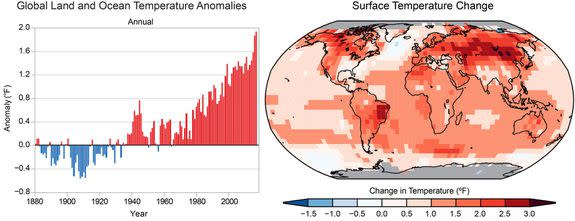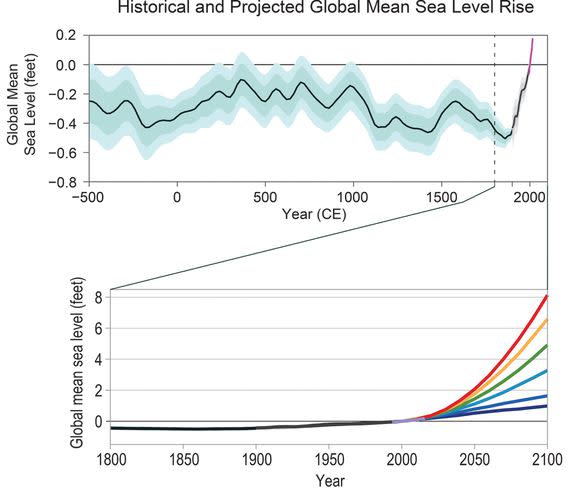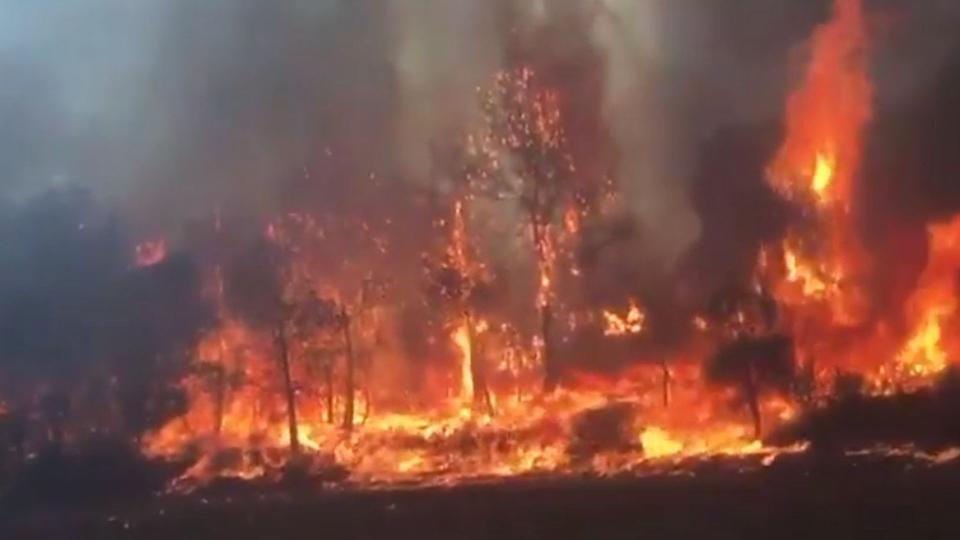Major federal climate report rebuts everything Trump administration has said about climate change

Global warming is real. It's happening because of human activities, and it's on the cusp of pushing the climate toward tipping points or other "unforeseen consequences" that could reshape the planet as we know it, warns a new federal report released on Friday.
The report, part of the Fourth National Climate Assessment, is mandated by Congress, and has undergone extensive peer review by the National Academy of Sciences, various federal agencies, and the public. It's the most up-to-date climate science report since the U.N. Intergovernmental Panel on Climate Change's last report was issued in 2013, and it paints an increasingly dire picture of where the planet — and the U.S. in particular, is headed.
SEE ALSO: Memo to Trump: Climate change could cost the U.S. government trillions
According to the report, global annually averaged surface air temperatures have increased by about 1 degree Celsius, or 1.8 degrees Fahrenheit, during the past 115 years. "This period is now the warmest in the history of modern civilization," the report states.

Image: nca4 executive summary.
The last three years alone have been the warmest years on record for the planet since record keeping began, and have featured "record-breaking, climate-related weather extremes," many of which cost billions of dollars.
Contrary to the waffling of Trump administration officials, who have sought to portray climate change as real but the cause of global warming as up for debate, the dozens of scientists who wrote this report found no ambiguity about causality.
The report states (original emphasis included):
This contradicts the views espoused by President Donald Trump, his administrator of the Environmental Protection Agency (EPA), and heads of the Interior and Energy departments.
EPA administrator Scott Pruitt has said that it's not clear how much human activities, such as burning fossil fuels for energy, are causing climate change.
"I think that measuring with precision human activity on the climate is something very challenging to do and there's tremendous disagreement about the degree of impact, so no, I would not agree that it's a primary contributor to the global warming that we see," Pruitt said in an interview on CNBC, when asked whether he thinks it's been proven that carbon dioxide is the main cause of global warming.
The report isn't exactly heartening
The new study includes updated estimates on sea level rise, and they're not comforting. The report finds that global average sea levels have risen by about 7 to 8 inches since 1900, but that about half that increase — 3 inches — has occurred just since 1993.
"Human-caused climate change has made a substantial contribution to this rise since 1900, contributing to a rate of rise that is greater than during any preceding century in at least 2,800 years," the report states.
The relatively small increase in sea level has already resulted in a large increase of so-called "nuisance flooding" in more than a dozen Atlantic and Gulf Coast cities, including Norfolk, Virginia and Miami.
“It’s having impacts that are detectable,” said Bob Kopp, an expert on sea level rise at Rutgers University, in an interview. He cited a five-to-ten-fold increase in nuisance flooding at some locations, and said this is only going to worsen in coming years.
The report projects that future sea level rise will amount to "at least several inches in the next 15 years" and 1 to 4 feet by 2100. The report's authors caution that an increase of as high as 8 feet by the year 2100 "cannot be ruled out," particularly if the Greenland and Antarctic ice sheets prove more sensitive to global warming than currently expected.
Compared to the previous National Climate Assessment, which was issued in 2014, this report contains more details on how extreme weather and climate events are changing nationwide. In general, it found that heavy rainfall is "increasing in intensity and frequency" across the U.S., though the increases are highest in the Northeast.
Heatwaves have also become more frequent since the 1960s, which is consistent with expectations from a warming climate, the report found.

Image: NCA4 Executive summary.
According to the report, between 2021 and 2050, annual average temperatures in the U.S. are expected to rise by about 2.5 degrees Fahrenheit, relative to the period from 1976 to 2005.
The report contains new warnings that the course of climate change beyond the year 2100 will depend on choices made in the next decade or two, since the magnitude of climate change will depend on the amount of carbon dioxide and other greenhouse gases emitted.
It's possible that if the world does not rein in greenhouse gas emissions, there could be as much as 5 degrees Celsius, or about 9 degrees Fahrenheit, of warming by the end of this century. Already, the amount of carbon dioxide in the air has passed 400 parts per million, which last occurred about 3 million years ago, at a time when sea levels and air temperatures were far higher than today.
"Continued growth in CO2 emissions over this century and beyond would lead to an atmospheric concentration not experienced in tens to hundreds of millions of years," the report warns.
Kate Marvel, a climate scientist at NASA, said the report drives home the fact that "climate change isn't a future issue, it's a current event. We're already experiencing changes in heat waves and heavy precipitation, rising seas, and forest fires," she said in an email.
"There are really no surprises here. It's getting warmer, it's our fault, and we have choices. We're very confident greenhouse gases have driven many observed climate changes. The level of greenhouse gases in the future will determine how bad it gets, and that's our decision," she said.
So far, the Trump administration's policy decisions have been to raise the likelihood that carbon dioxide emissions won't fall according to the most ambitious scenarios outlined in this and previous reports. President Trump announced in June that he's pulling the U.S. out of the Paris Climate Agreement, joining just one other country — Syria — in standing against that treaty. The agreement, which went into force in 2016, aims to limit global warming to well under 2 degree Celsius, or 3.6 degrees Fahrenheit, compared to preindustrial levels by the year 2100.
Trump, along with Pruitt and the rest of his cabinet, have also been dismantling the Obama administration's regulations put in place to cut emissions, including a plan to limit emissions from coal-fired power plants.
There are really no surprises here. It's getting warmer, it's our fault, and we have choices.
Therefore, the report has an air of cognitive dissonance to it, given the huge gap between the conclusions of federal science agencies and federal policies.
The National Climate Assessment is mandated to occur every 4 years under a 1990 law passed by Congress. This chapter, known as the Climate Science Special Report, was already well into its review phase when Trump took office, which made it difficult for the Trump administration to stop, slow, or subvert the process.
Katharine Hayhoe, a climate scientist at Texas Tech University and one of the authors of the new report, said it's "One of the, if not the, most thoroughly peer-reviewed climate science reports ever produced in the United States."
"The findings of this report underscore what we’ve known to be true for decades: that climate is changing, humans are responsible, and the risks are serious. It also quantifies how every additional gigaton of carbon we produce narrows the window of opportunity to meet global temperature targets and "prevent dangerous human interference with the climate system.”
Unlike the previous National Climate Assessment, the new one, of which the report released Friday is just a part, discusses the potential for nasty climate change surprises.
"There is broad consensus that the further and the faster the Earth system is pushed towards warming, the greater the risk of unanticipated changes and impacts, some of which are potentially large and irreversible," the report states.
Examples of such unforeseen changes include a shutting down or dramatic slowing of the Atlantic Meridional Overturning Circulation, of which the Gulf Stream is a part, as well as the loss of huge portions of the Antarctic and Greenland Ice Sheets.
"We care about a changing climate because it affects us," Hayhoe said. "As the planet warms, many of the natural risks we already face, from heatwaves and wildfires to hurricanes and floods, are amplified. And the further and the faster it changes, the greater the risk of such impacts, on our food, our water, our health, our economy and more."
WATCH: Summer 2017 feels like it's on steroids – and it's only going to get worse


